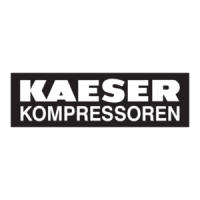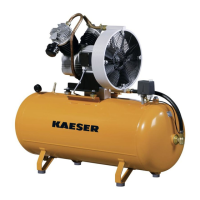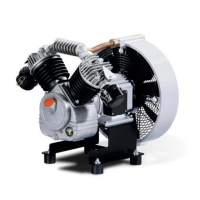Do you have a question about the KAESER EPC 550-2-250 and is the answer not in the manual?
Covers basic requirements and specifications for the three-phase power supply connection.
Details voltage, frequency, and connection requirements for three-phase power.
Defines the intended industrial use of the machine and disclaims liability for other uses.
Lists actions constituting improper use, such as directing air at people or operating in hazardous areas.
Outlines user duties regarding regulations, personnel, and inspection schedules.
Stresses compliance with national and European safety and accident prevention regulations.
Specifies qualifications required for authorized operators, installers, and maintenance personnel.
Emphasizes the need to follow inspection schedules and accident prevention rules.
Provides information on various dangers arising during machine operation, categorized by type.
Details safety precautions for electricity, forces of compression, air quality, spring forces, and rotating components.
Offers guidelines for safe machine handling, including temperature, noise, and fluid precautions.
Covers designation of personnel, reporting procedures, and fire-fighting instructions.
Explains the function of safety devices and the importance of not altering or disabling them.
Illustrates and explains the meaning of various safety signs found on the machine.
Provides guidance on emergency procedures, including fire fighting and first aid.
Lists suitable and unsuitable extinguishing agents and steps to take during a fire.
Details first aid procedures for eye and skin contact with compressor oil.
Lists and explains safety devices like pressure relief valves, check valves, and enclosures.
Requirements for machine installation, including location, clearances, and floor stability.
Guidelines for safely connecting the machine to the power supply by authorized personnel.
Basic safety instructions and warnings for initial start-up procedures.
Highlights the importance of correct initial start-up to prevent machine damage.
Checklist of installation and operational conditions to verify before first start-up.
Ensuring the motor is operated with a correctly adjusted overload protection switch.
Details on setting the motor overload protection switch based on phase current.
Steps for safely starting the machine for the first time and initial checks.
Instructions on how to set the network working pressure to suit operating conditions.
Guidance on adjusting the pressure regulator to maintain constant working pressure.
Instructions for operating the machine using the ON/OFF switch and considerations for automatic restart.
Details on the star-delta starting procedure, including preconditions and switching on steps.
General information on alarm indications and fault rectification procedures.
Table listing faults, their possible causes, and recommended remedies.
Essential safety instructions for performing maintenance work on the machine.
Guidelines for scheduling and logging maintenance tasks based on operating conditions.
Lists routine maintenance tasks with specified intervals and corresponding chapters.
Defines regular service tasks to be performed by authorized technicians at specific intervals.
Procedure for checking the compressor oil level using the oil sight glass.
Instructions for safely topping up the compressor oil, including precautions against mixing types.
Guidance on draining and refilling the compressor oil, with notes on oil monitoring function.
Procedures for testing the functionality of pressure relief valves.
Steps to safely vent the machine (de-pressurise) before maintenance work.
Covers basic requirements and specifications for the three-phase power supply connection.
Details voltage, frequency, and connection requirements for three-phase power.
Defines the intended industrial use of the machine and disclaims liability for other uses.
Lists actions constituting improper use, such as directing air at people or operating in hazardous areas.
Outlines user duties regarding regulations, personnel, and inspection schedules.
Stresses compliance with national and European safety and accident prevention regulations.
Specifies qualifications required for authorized operators, installers, and maintenance personnel.
Emphasizes the need to follow inspection schedules and accident prevention rules.
Provides information on various dangers arising during machine operation, categorized by type.
Details safety precautions for electricity, forces of compression, air quality, spring forces, and rotating components.
Offers guidelines for safe machine handling, including temperature, noise, and fluid precautions.
Covers designation of personnel, reporting procedures, and fire-fighting instructions.
Explains the function of safety devices and the importance of not altering or disabling them.
Illustrates and explains the meaning of various safety signs found on the machine.
Provides guidance on emergency procedures, including fire fighting and first aid.
Lists suitable and unsuitable extinguishing agents and steps to take during a fire.
Details first aid procedures for eye and skin contact with compressor oil.
Lists and explains safety devices like pressure relief valves, check valves, and enclosures.
Requirements for machine installation, including location, clearances, and floor stability.
Guidelines for safely connecting the machine to the power supply by authorized personnel.
Basic safety instructions and warnings for initial start-up procedures.
Highlights the importance of correct initial start-up to prevent machine damage.
Checklist of installation and operational conditions to verify before first start-up.
Ensuring the motor is operated with a correctly adjusted overload protection switch.
Details on setting the motor overload protection switch based on phase current.
Steps for safely starting the machine for the first time and initial checks.
Instructions on how to set the network working pressure to suit operating conditions.
Guidance on adjusting the pressure regulator to maintain constant working pressure.
Instructions for operating the machine using the ON/OFF switch and considerations for automatic restart.
Details on the star-delta starting procedure, including preconditions and switching on steps.
General information on alarm indications and fault rectification procedures.
Table listing faults, their possible causes, and recommended remedies.
Essential safety instructions for performing maintenance work on the machine.
Guidelines for scheduling and logging maintenance tasks based on operating conditions.
Lists routine maintenance tasks with specified intervals and corresponding chapters.
Defines regular service tasks to be performed by authorized technicians at specific intervals.
Procedure for checking the compressor oil level using the oil sight glass.
Instructions for safely topping up the compressor oil, including precautions against mixing types.
Guidance on draining and refilling the compressor oil, with notes on oil monitoring function.
Procedures for testing the functionality of pressure relief valves.
Steps to safely vent the machine (de-pressurise) before maintenance work.
| Brand | KAESER |
|---|---|
| Model | EPC 550-2-250 |
| Category | Air Compressor |
| Language | English |











